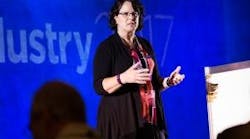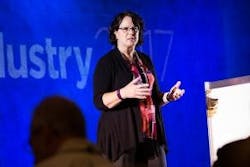How Exelon promotes a culture of digital innovation
By Paul Studebaker
As perhaps the most regulated, safety-conscious and secured industry in the world, nuclear power might seem to be the last place to find innovation powered by Internet-enabled technologies. But that’s what attendees of Smart Industry 2017 learned about in the keynote presentation, “Exelon innovating its way to the digital plant of the future,” by Exelon Generation innovation director Joan Knight.
“Digital transformation centers around three areas: people, process and assets.” Exelon’s Joan Knight discussed how the company is making many small bets to find a few innovations that pay off big, as well as investing in successful trials to make those payoffs even bigger.
The job title “innovation director” may seem somewhat less than industrial-strength, but not at Exelon. Knight holds a BS in ChemE and MS in MetE from IIT. Over the past 27 years, she graduated through positions in engineering, management and oversight at Exelon, including three years as engineering director at its Dresden plant, and became innovation director in 2014.
Exelon provides electric power generation and distribution in five states and Washington, D.C. to 10 million customers. It’s the largest industrial supplier in the United States. Of its 33 GW generation capacity, 20 GW is nuclear, 6.6 GW is natural gas, 1.6 GW is hydro, 1.5 GW is wind, and 500 MW is solar. Exelon is the largest nuclear operator in the U.S., third-largest in the world, and the largest non-government-owned.
Powerful challenges
The dynamics of energy pose a challenge to all electric power suppliers, especially one with the broad but nuclear-heavy portfolio of Exelon. Knight listed flat to low demand growth, accelerating technology deployment, evolving consumer expectations, low natural gas prices, growing interest in clean generation, and more local deployment of generating capacity.
In a large, well-established company, the ability to innovate depends strongly on the ability to drive culture change. For this, Exelon draws on a familiar set of tools:
- Establishing a process: Implementing an Exelon methodology through frameworks and events;
- Providing technology so employees can connect and communicate across the company;
- Using metrics to measure the culture and capability for innovation, tracking progress over time;
- Messaging and communications;
- Rewards and recognition; and,
- Training, to build and communicate skills, techniques and tips.
“A solid foundation in these areas enables innovation for efficiencies and growth, a shift in mindset, and engages employees,” Knight said.
To establish a baseline and measure progress, Exelon asked 10,000 employees to assess the company in six areas:
- Leadership: Is the vision clear and are leaders aligned?
- Organization: Is the way we organize for innovation effective?
- Learning: Does the company learn by capturing and harvesting insights?
- Process: Do the processes in the company encourage or deter innovation?
- Capabilities: Do we possess the necessary capabilities to innovate successfully?
- Culture: Is the company culture conducive to innovative thought and action?
Growing culture change
A variety of programs are used to foster innovation, including “Giraffe” awards for “sticking ones neck out, even when the results are not successful,” Knight said. “We work on developing many new projects so some can become big, and on making the impact of big projects even bigger.”
A major contribution to culture shift is made by an annual Innovation Expo, which “inspires and connects people,” Knight said. The Expo is attended by 2,600 employees and features 400 presentations, including 100 guest speakers.
It’s a full conference with panel discussions, keynotes, an inspirational speaker, vendor displays and its own mobile app. Highlights include employee innovations, latest technologies, fast pitch presentations, and innovation awards.
“Digital transformation centers around three areas: people, process and assets,” Knight said. The enabling technologies are IoT-connected sensors and smart devices, advanced analytics, drones and robotics, artificial intelligence, and “digital worker experience—tools to help workers visualize, provide, process and access information,” she said.
Innovation in action
In nuclear powerplants, Exelon’s digital transformation goals center on “enabling greater efficiencies through deeper insights,” Knight said. The goals are to:
- Simplify processes to improve productivity;
- Drive employee and knowledge retention;
- Recognize organizational risk sooner; and,
- Support centralization of functions.
Exelon has implemented “Digital Plant Viewer,” an interactive map with 360-degree views of every level in the plant, showing radiation levels in an active view with virtualization. “Any tablet or phone on our system now can access it.” Along with providing a comprehensive overview, the viewer reduces operator travel time and risk of exposure to radiation. It also empowers maintenance by increasing visibility and easing communications.
A “Vehicle Search Application” is used at security checkpoints to guide the security officer when checking trucks and equipment coming in. “It makes sure inspections are thorough and correct, shows schedules and minimizes delays, which avoids surcharges if trucks have to wait,” Knight said.
A third application, Lighthouse, resulted from working with GE to implement Predix across the generating facilities. “Lighthouse predicts with high accuracy the risk of an adverse event based on history and analytics,” Knight said. “It predicts three to four months out. The dashboard shows the risk, why and how to prevent a problem to avoid the costs and lost revenue of outages.”
The company now has the leadership, processes, metrics, technologies and change management practices it needs to meet today’s challenges in power production and distribution. Knight said, “With these cultural and digital innovations, we think we’re going to reinvent Exelon.”




